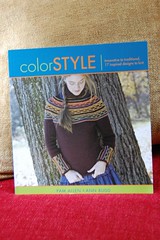First, the facts:
Title: Color Style: Innovative to Traditional
Authors: Pam Allen and Ann Budd
Published by: Interweave Press, 2008
Pages: 143
Type: Patterns.
Chapters:
1. Color Your World; 2. Color Patterns; 3. Gee’s Bend Pullover; 4. Holi Mitts; 5. Mohair Fair Isle; 6. Faux-Embroidery Yoke Sweater; 7. Honeycomb Turtleneck; 8. Bohus-Style Knee-Highs; 9. Harvest Cardigan;
10. Hooded Scarf; 11. Funky Fair Isle Bag; 12. Mosaic Yoke Jacket; 13. Cunningsburgh Star Jacket; 14. Peace and Love Gloves; 15. Retro Andean Pullover; 16. Argyle Vest; 17. Floral Pillow; 18. Striped Raglan; 19. Fun Flower Mittens; 20. Design Notebook
Pattern Size Range: It varies–ranges from 33″ to 49″
The In-Depth Look:
I’ll confess that I mostly bought this book solely because I liked the cover sweater so much, but that I fully expected not to be that impressed with the rest of the book. I’d been disappointed with Lace Style, you see, which wasn’t terrible, but didn’t include anything that I would have wanted to knit. So, I was prepared to feel lukewarm about this one, all for the sake of that cover sweater.
Well, what a pleasant surprise. Out of the seventeen projects, there are fully seven sweaters and three accessory patterns that I would consider making, and four or five of them I really want to make. (Ironically, the cover sweater isn’t one of them. Go figure.)
So. Details. The ones I love? The very first sweater in the book, the Gee’s Bend Pullover is a winner. Knit in panels with asymmetrical stripes in great earth tones … Beautiful. About the only drawback is that it IS knit in panels, meaning there are extra seams. I find the construction of that intriguing and wonder why it’s not knit in color blocks, but there’s no question the result is a really flattering pullover. The Faux-Embroidery Yoke Sweater also appeals to me–not only does it have that nice, traditional color-yoke look, but the extra detail comes from fake embroidery that’s knit into the sweater, rather than embroidered–a technique I don’t recall seeing before. Love that. The braid around the edges, in place of ribbing, is a great, contrasting touch, too.
Then there’s the Harvest Cardigan–a traditional Fair Isle in that it’s knit in the round with the front and sleeves cut in with a steek. This particular sweater has a one-color background, with the Fair Isle pattern knit in in shades of golds and yellows, and I’ve got to tell you. I’m in love with this sweater. The Mosaic Yoke Jacket is an intricate mesh of mosaic color work, mostly in a neutral black/white pattern, but with a burst of color at the yoke. About the only thing I don’t like about it is that there’s no way to close it. (The model wears it belted–a trend which I sincerely hope ends soon.)
Then there’s a classic raglan sweater, knit in tiny, horizontal color stripes. A modern Argyle vest–with a block of argyle pattern in the front, and simple ribbing in the back. The cover sweater, I still think is intriguing, but on closer look at the pictures, I’ve decided that it wouldn’t fit me very well (and I hate wearing turtlenecks, though I could change that).
I thought the Cunningsburgh Star jacket was a little busy, I thought, and its gathered-waist tie makes it bulky, too. The Retro Andean Pullover had some interesting geometric
designs, but I thought it was much too short and the bright colors aren’t to my taste–and either of those things, of course, could be changed. Then there was the Mohair Fair Isle which looks sweet and soft and pretty, but its Fair Isle sections are knit back and forth in rows and, I’m sorry, doing color work while purling is not my idea of a good time–no matter how pretty the sweater.
Then there are the accessories. How great are Veronik Avery’s Peace and Love gloves? Herringbone pattern for the hands, with the words “Peace” and “Love” knit into the wrists. Then, there’s the brightly colored, fun hooded scarf with garter-stitch stripes of color and embroidered flowers. Bohus-inspired socks. Fingerless mitts. A playful felted pillow. Mittens with intarsia flowers.
Beyond the actual patterns? The photos in the book are generally good–in that they look attractive, without the tell-tale slouch or hide-behind-props trick that many knitting books use. There are detailed close-ups of specific elements, as well as artistic renderings of extra details like embroidery touches. The “Design Elements” chapter explains the different color techniques. There’s an index and a listing of patterns in the contents, so you can find them later.
Really, I liked this book, can you tell? (Honestly. You’re all going to start thinking I can’t write a bad review.) The patterns might not all have been perfect, but compared to the lace book, about which I felt merely lukewarm, this is a relief.
Now, if you’ll excuse me, I’m going to go check my stash to see if I have the yarn for that Harvest Cardigan because, yes, I liked it that much.
Want to see bigger pictures? Click here.




Comments on this entry are closed.